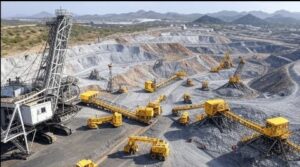Calgary, Alberta CANADA, Jun 09, 2014 (Filing Services Canada via COMTEX) — Morro Bay Resources Ltd. (MRB – TSX Venture), (“Morro Bay”) is pleased to announce the completion of the recent drilling campaign on the Penoles Project (the “Penoles Property”) which is owned by Riverside Resources Inc. (“Riverside”) /quotes/zigman/478675/realtime CA:RRI +6.49% . From February to May, 2014 Morro Bay completed twenty three (23) HQ sized core holes on the property, for a total of 2,143 meters. The majority of the drilling was focused in and around the Jesus Maria mine workings stepping out from the previous exploration drilling that had been conducted in the area.
Results of the 2014 Morro Bay Drill Program:
During the program, the newly generated surface and drill hole geology, and incoming drill assays discovered a new zone of mineralization and structural preparation (referred to as the “Jesus Maria South Zone”) to the south of the Jesus Maria mine area that had not been systematically tested and apparently never worked by previous mining. The first two drill holes that intersected the new zone, (JM DDH 14-10 and JM DDH 14-24) returned the best near surface intervals of silver mineralization intersected at the Penoles Property since Riverside acquired the property in 2007.
The first hole drilled (JM DDH 14-10) was a 30 metre step out, south from the final hole (JM DDH 13-9 “Hole 9”) of the 2013 program. This drill hole, (JM DDH 14-10), was vertical and intersected an approximately 41 metre wide near-surface mineralized interval averaging 123.9 g/t silver and more than 0.5 g/t gold, including a 4.25 metre interval that assayed 732.2 g/t silver and 1.20 g/t gold. The second hole, JM DDH 14-24 was a 50 meter step out to the northwest from hole JM DDH 14-10, and was inclined to the south. Assays for hole, JM DDH 14-24, confirmed significant widths of mineralization, with a 70.8 m interval averaging 147.8 g/t silver including a 22.7 m interval that returned 388.4 g/t silver. Assay results for the drill holes received to date from the Jesus Maria South Zone, JM DDH 14-10 and JM DDH 14-24, are summarized below:
-------------------------------------------------------------------------
Hole ID From(m) To(m) Interval(m) Au(ppm) Ag(ppm) Pb(%) Zn(%)
-------------------------------------------------------------------------
JM DDH 14-10 18.9 59.5 40.60 0.540 123.9 0.07 0.14
-------------------------------------------------------------------------
Including 27.7 31.95 4.25 1.201 732.2 0.13 0.35
-------------------------------------------------------------------------
Including 40.95 43.25 2.30 1.291 194.8 0.42 0.31
-------------------------------------------------------------------------
Including 50.3 57.0 6.70 1.082 122.9 0.05 0.12
-------------------------------------------------------------------------
JM DDH 14-24 52.65 123.45 70.80 0.37 147.8 0.03 0.08
-------------------------------------------------------------------------
Including 67.8 90.5 22.70 0.629 388.4 0.07 0.12
-------------------------------------------------------------------------
Including 101.9 107.35 5.45 1.474 144.2 0.11 0.06
-------------------------------------------------------------------------
(All reported intervals are core lengths, true widths have not yet been determined)
Six additional holes (JM DDH 14-25 through JM DDH 14-30) have been drilled to investigate the potential continuity of mineralization at the Jesus Maria South Zone to the east of JM DDH 14-24. The Jesus Maria South Zone is open for expansion along strike to the west southwest of JM DDH 14-24. Assay results for these six holes will be released once they become available.
The discovery of the Jesus Maria South Zone (see Figure 1) significantly increases the potential in the Jesus Maria region of the property and further demonstrates the prospectivity of the Penoles Project. Preliminary modelling suggests that the Jesus Maria South Zone is dipping to the north and merges at depth with the Jesus Maria target forming a near surface trough or wedge shaped mineralized zone which could be amenable to low cost open pit mining.
John Zang, CEO of Morro Bay stated that “These drill results appear to confirm our preliminary assessment of the value creating opportunities at Penoles Property. The Jesus Maria South mineralization zone, combined with the previously identified silver and gold zones could potentially set the foundation for a viable mining project on the property. I am particularly pleased by the results from several of the assayed holes in this drilling campaign, as they appear to be consistent with our theory of the potential for an open pit mineable deposit at the Penoles Property.”
Figure 1: Drill hole plan (Jesus Maria and Jesus Maria South areas)
To view Figure 1, click onto the following link:
http://www.usetdas.com/maps/morrobay/morrobayjune92014003.gif
Other assayed holes from the current campaign include drill holes JM DDH 14-11 through JM DDH 14-23 which are a series of vertical and inclined holes spaced at 50 – 100 meter intervals to test for west extensions of the Jesus Maria Zone and potential extensions of the deeper mineralized zone within the historical Jesus Maria mine area. These holes encountered significant mineralization as tabulated below. These results are currently being integrated into the Jesus Maria geological model.
-------------------------------------------------------------------------
Hole ID From(m) To(m) Interval(m) Au(ppm) Ag(ppm) Pb(%) Zn(%)
-------------------------------------------------------------------------
JM DDH 14-11 81.30 93.30 12.00 0.284 42.6 0.61 1.13
-------------------------------------------------------------------------
JM DDH 14-12 Hole was abandoned before reaching target depth
-------------------------------------------------------------------------
JM DDH 14-13 100.90 113.30 12.40 0.226 55.9 0.04 0.11
-------------------------------------------------------------------------
and 146.30 157.80 11.50 0.280 36.7 0.16 0.34
-------------------------------------------------------------------------
JM DDH 14-14 41.00 58.65 17.65 0.122 123.3 0.94 0.78
-------------------------------------------------------------------------
JM DDH 14-15 29.00 36.05 7.05 0.233 34.7 0.53 0.57
-------------------------------------------------------------------------
JM DDH 14-16 36.05 38.40 2.35 0.187 53.9 1.16 1.02
-------------------------------------------------------------------------
JM DDH 14-17 74.50 76.80 2.30 0.149 56.6 2.22 1.76
-------------------------------------------------------------------------
JM DDH 14-18 56.3 60.8 4.50 0.064 50.9 0.78 0.72
-------------------------------------------------------------------------
JM DDH 14-19 Did not encounter any significant mineralization
-------------------------------------------------------------------------
JM DDH 14-20 Did not encounter any significant mineralization
-------------------------------------------------------------------------
JM DDH 14-21 37.95 39.85 1.90 0.254 251.4 0.01 0.02
-------------------------------------------------------------------------
and 113.20 129.35 16.15 0.100 39.4 0.25 0.38
-------------------------------------------------------------------------
JM DDH 14-22 28.9 59.55 30.65 0.178 41.4 0.03 0.11
-------------------------------------------------------------------------
Including 44.9 47.15 2.25 0.128 179.2 0.09 0.16
-------------------------------------------------------------------------
including 54.15 57.1 2.95 0.938 138.4 0.14 0.29
-------------------------------------------------------------------------
and 70.45 93.05 22.60 0.346 26.4 0.40 0.61
-------------------------------------------------------------------------
JM DDH 14-23 25.3 56.5 31.20 0.112 55.7 0.17 0.33
-------------------------------------------------------------------------
Two additional drill holes (CDDH-14-49 and CDDH-14-50) were designed to test potential down dip extensions of the El Capitan target but did not reach target depth due to local ground conditions and were not submitted for assay.
Prior Exploration at the Penoles Project:
The Penoles Project is located in the Durango Silver Belt in North-Central Mexico and includes two past producing silver mines (referred to as the Jesus Maria and San Rafeal) and an oxide gold prospect (referred to as the El Capitan). The El Capitan and Jesus Maria regions of the Penoles Property were previously the focus of several drill programs completed between 2011 and 2013 by Sierra Madre Developments /quotes/zigman/13459843/realtime CA:SMG +50.00% and Riverside Resources /quotes/zigman/478675/realtime CA:RRI +6.49% . The Property also includes multiple (11 targets) early stage exploration targets which have not yet been drill tested by Morro Bay.
There are currently approximately eleven targets on the Penoles Project, including the El Capitan gold zone, the Pinchanzo Zone (see Riverside press release dated May 23, 2012), potential west extensions of El Capitan (referred to as the West Extension), a new target area located to the northwest of El Capitan (referred to as Santa Theresa or the Capitan Northwest Zone) and the previously mined Jesus Maria and San Rafael Ag-Au-Pb-Zn mines. The district is highly prospective with active mining operations nearby and has proven to be a safe and cost effective region where projects can be efficiently developed towards production.
The results of previous drill programs are disclosed in Morro Bay’s NI43-101 Technical Report dated November 15, 2013 which was filed on SEDAR ( www.sedar.com ) on December 19, 2013. The past drill results are also contained in the Morro Bay Corporate Presentation which can be found at its websitewww.morrobayresources.com .
Jesus Maria-Prior Drilling: Prior to the holes drilled in 2014, a total of 10 drill holes have previously been drilled at Jesus Maria totaling approximately 1,176 meters and having total intervals of mineralization of approximately 148 meters. As reported in the Riverside news release dated June 10, 2013, prior trenching near the historical Jesus Maria mine workings discovered that there is a much wider zone of mineralization than previously recognized, and revealed that there are two vein types. The first vein type is the previously known main silver-gold-zinc-lead, silica-rich Jesus Maria vein. The second, newly recognized, vein type lies structurally above the Jesus Maria vein exhibiting significant silver values with abundant carbonate in a wide vein zone. This increases the potential for a bulk mineable resource, and provided new drill targets. The 2013 drilling intercepted this wider semi-parallel sequence of upper silver-carbonate rich veining as well as the main quartz-rich Ag-Au-Pb-Zn Jesus Maria vein zone. Underground exploration and sampling of the old workings also discovered silver bearing carbonate veins, which prior to this recent work, was not known and demonstrates larger potential for the Jesus Maria vein system than previously recognized. The 2014 drilling has further added to the prospectivity identified by the 2013 drill campaign.
El Capitan-Prior Drilling: A total of approximately 6,945 meters of drilling has occurred at El Capitan through 45 drill holes and showing total intervals of mineralization of approximately 2,969 meters. The El Capitan Target is considered to be an oxide gold prospect. Previous drill programs at El Capitan have confirmed the hypothesized epithermal style gold deposit located at the basal geologic contact. This geologic feature appears to be predictable and so far consistently traceable laterally into a wide and continuous surface exposed volcanic-sedimentary contact similar to other known gold districts such as Round Mountain, Nevada and Mulatos, Sonora. Preliminary geological work indicates potential for a bulk tonnage, low grade deposit.
Expenditure to Exercise Option:
The drilling campaign on the Property was conducted pursuant to a commitment by Morro Bay to incur exploration expenses in the amount of $750,000. The incurring of the $750,000 expenditures is a pre-requisite to Morro Bay being entitled to exercise the option to earn an initial 51% interest and up to 65% interest in the Property. Subject to the right of Riverside to review and dispute the expenditures incurred by Morro Bay as set out in the Amended and Restated Option Agreement dated January 22, 2014 (filed on SEDAR by Morro Bay on January 22, 2014) (the “Option Agreement”), Morro Bay has incurred the required expenditures. The Option Agreement further provides, inter alia, that in order to exercise the option, Morro Bay is required to pay Riverside $1.35 million cash ($100,000 and USD$1,250,000) and $1.5 million worth of Morro Bay Shares (or cash at Morro Bay’s option, provided that if the market value of the Morro Bay Shares is less than $0.05 based on a 30 day VWAP, such payment must be made in cash) by June 30, 2014. Morro Bay has not yet provided notice to Riverside of its intention to exercise the Option.

















